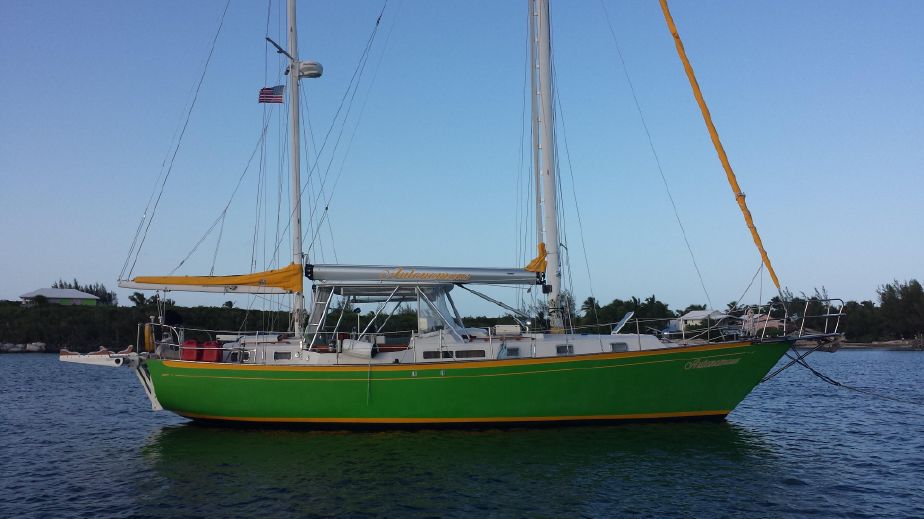In addition to being a writer, yachtsman, and educator, Ted Brewer has long been recognized as one of the outstanding designers of cruising boats of all kinds. His work includes numerous custom designs as well as many production boats, ranging from the Sharpie-styled Nimble 26 to the Islander 48. Brewer’s designs always stand out for their practicality, comfort, and well-mannered performance. To my eye, Brewer’s designs are always handsome and rugged-looking even though they don’t always possess classic beauty and style.
Introduced in 1972, the Whitby 42 is vintage Ted Brewer and was arguably his most commercially successful design. First built by Whitby Boat Works of Ontario, Canada and later under a license agreement by Ft. Meyers Yacht and Shipbuilding, the Whitby 42 was in production until 1988. About 300 boats were built.
Construction of the Whitby 42 is generally sound for a coastal cruiser. However, many of these boats are put to the test of extended offshore passages, and there are a few details I am not particularly fond of for offshore sailing. The hull is constructed of a composite of alternate layers of fiberglass mat and woven roving with polyester resin. A balsa wood core is used from just below the sheer to about a foot below the static waterline. Decks are constructed of fiberglass cloth and mat with balsa wood core and are fastened to the hull on an inward flange. One of those details not particularly to my liking is Whitby’s liberal use of pop-rivets as a means of fastening structural components. Even the deck-to-hull joint of most Whitby 42s is fastened with pop-rivets, fiberglass and resin. Some 42s were built with the deck-to-hull joint completely through bolted--my prefered method. Whitby offered this as an option at an extra cost. I will admit many Whitby 42s have made significant offshore passages, and I am not aware of any catastrophic structural failures.
Auxiliary power is provided by a 67 HP Ford Lehman diesel engine installed beneath the cockpit deck. This is plenty of power for a 23,000 lb. cruising boat, and the 200+ gallon fuel tank provides a cruising range of more than 1,200 miles without refueling. The engine room is easily accessed for service and, if engine replacement or major overhaul is ever necessary, the cockpit sole is removable. The engine room is large enough to accommodate a small auxiliary generator along the port side.
Under sail, the performance of the Whitby 42 is a bit sluggish through tacks in light air. Her windward performance is acceptable but not outstanding and she has very respectable speed on reaches and runs particularly in moderate to heavy air. The addition of a mizzen stay sail and spinnaker will help light air downwind performance. Some Whitby 42s were built with an optional bow sprit. Others have had this feature retrofitted reportedly improving the balance and weatherly performance of the boat significantly. With 5’ draft, a ballast to displacement ratio of .34, and fairly round hull sections, the Whitby 42 is a bit tender when the wind freshens. You’re likely to reef a little sooner than the boat’s robust appearance might suggest.
The strength of the Whitby 42 clearly lies in her accommodations. There are good sized staterooms forward and aft, and both have large adjoining heads with showers. The "U" shaped galley is spacious and perfectly positioned to keep the cook out of the way of passengers and crew. In addition, there is a large saloon, comfortable navigation station and even a work bench along the passageway between the navigation station and after stateroom. The Whitby 42 is justifiably regarded as one of the most livable production boats to be found in this size range.
Weak points of the Whitby 42 include the aforementioned pop-riveted fastenings, which are prone to work loose, and compression failures under the mizzen mast step that result from the use of balsa wood core and inadequate structural support. For all its great dockside accommodation the Whitby 42 lacks good sea berths for offshore passages, and extra hand-holds are strongly advised if you plan to sail offshore. And, although it’s nit-picking a bit, the forward water tank seems to develop persistent leaks around the lid.
The Whitby 42 remains a very popular choice for liveaboard cruisers of moderate means. It’s a good value and properly outfitted, sailed and maintained, is capable of taking you to great cruising destinations.
Reviewed in the May 1997 issue of SpinSheet by Jack Hornor





